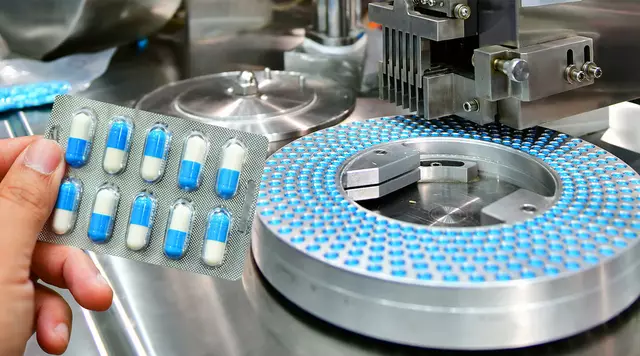You don’t need to be a medical geek to have heard about Topamax. While the name sounds like a top-secret gadget, it’s actually a medication thousands of people rely on daily to manage migraines and epilepsy—two conditions that can completely reshape your day-to-day life. If someone you know mentioned taking Topamax and you’ve seen debates about its benefits (and side effects) on every health forum, join the club. It’s one of those drugs that sparks curiosity, confusion, and sometimes, strong opinions.
What Is Topamax and How Does It Actually Work?
Pop open most medicine cabinets of migraine or epilepsy patients in Manchester (or anywhere really), and you’re likely to find a familiar little pill or cap labeled Topamax. That’s the friendly trade name for topiramate. Doctors have used this drug since the 1990s to help prevent seizures and stop those brutal migraine attacks before they even begin. What’s the science? Topamax mainly works by calming nerve activity in the brain. It sort of dials down the volume on those excessive signals that can set off a seizure or a migraine. So, it doesn’t treat the attack once it starts—it tries to stop one from happening at all. Pretty handy, right?
The use of Topamax spans a few different territories. Most people think of headaches and epilepsy, but docs sometimes prescribe it for things like weight loss (mainly when it’s combined with another drug), mood stabilization, or even off-label conditions like PTSD or alcohol use disorder. That’s a lot for one tablet—but let’s talk specifics. For epilepsy, Topamax has proven in reliable clinical studies to reduce the number of seizures, especially for people who haven’t responded to first-line treatments. It’s used in both adults and children and can be given alone or alongside other anti-seizure meds.
When it comes to migraines, Topamax is a star player in prevention—not for knocking out a headache when it strikes, but for people who deal with frequent migraines, like four or more each month. In research published in Neurology, about half the migraine sufferers on Topamax saw their headache days cut in half. That’s huge if you’re used to missing school, work, or just quality time because of pounding pain and nausea.
Doctors start people on low doses, creeping up over several weeks. Why so slow? The body needs time to adjust, and this careful ramp-up can help dodge some of the more frustrating side effects (more on that soon). Dosing for epilepsy and migraine prevention usually lands anywhere from 50mg up to 400mg daily, but your doctor will set the plan based on what you’re dealing with.
Ever wonder about how Topamax’s cost stacks up? In the UK, the generic form, topiramate, is what you’ll usually get, and it’s relatively inexpensive compared to some newer options. A standard prescription from your GP won’t break the bank, especially if you’re getting it for chronic migraine through the NHS. But if you’re in a spot where you’re paying out of pocket, prices can vary by pharmacy, so it’s smart to shop around or check discount programs.
If you want a quick breakdown of Topamax’s approved uses, here’s a handy table:
| Condition | Age Group | Typical Dosage Range |
|---|---|---|
| Epilepsy | Adults & Children (2+ years) | 50-400mg daily |
| Migraine Prevention | Adults & Teens (12+ years) | 50-100mg daily |
| Off-Label Uses (weight, mood) | Varies | 25-100mg daily |
So, to sum up, Topamax is far from a one-hit wonder in the medicine world. Its action on brain cells keeps both headaches and seizures in check, but people searching for quick relief during a migraine should look elsewhere—it’s all about the long game with this med.

The Surprising Side Effects and What You Can Actually Do About Them
This is where things get interesting—and, let’s be real, a bit worrying for some. The number-one topic in forums about Topamax? Side effects. It’s what can turn patients off or spark awkward conversations with friends who recognize “that look.” While some people glide through treatment with barely a blip, others run into issues like brain fog, taste changes, or a sudden craving for a warm jumper on a summer’s day (if you know, you know).
The classic complaint with Topamax? Cognitive fuzziness. People nickname it “Dopamax” for good reason. Getting the words out, remembering simple things, or just tracking a TV plot can feel way harder. In fact, researchers in a 2022 patient survey found that up to 30% of users described some kind of cognitive clouding. For students or anyone working with numbers, it might feel like someone’s put the brake on your brain. The good news: these effects often ease off as your body adapts or if your dose stays low. But if it’s tanking your work or relationships, talk to your doctor straight away—sometimes a lower dose solves the problem.
People also notice their sense of taste goes weird. Fizzy drinks taste flat, favourite crisps suddenly seem bland, and everyday meals can feel off. About 10% of users report taste disturbances or appetite changes. Oddly enough, for some, the result is unintended weight loss—sometimes celebrated, sometimes worrisome. If you’re losing your appetite, add extra snacks into your routine or explore high-calorie shakes so you don’t drop too many kilos without meaning to.
Let’s talk numbers. Here are the most common side effects, based on data from the UK NHS and US FDA:
| Side Effect | How Common? |
|---|---|
| Pins and needles (hands/feet) | Up to 50% |
| Cognitive issues (memory, focus) | Up to 30% |
| Appetite loss / Weight loss | 10-15% |
| Metallic taste / Taste changes | 10% |
| Drowsiness or sleepiness | 10-15% |
| Kidney stones | 1-2% |
| Vision changes / Glaucoma | Rare (<1%) |
Most side effects pop up in the first few weeks or if the dose goes up quickly. Doctors warn you to drink plenty of water because Topamax can increase your risk of kidney stones, especially if you’re active or it’s a hot summer. A study done in Manchester last year found that active adults on Topamax who didn’t hydrate enough had a much higher risk—something as simple as an extra pint of water each day cut that risk almost in half.
Women thinking about pregnancy need an extra chat with their prescriber. Topamax raises the risk of birth defects if taken during the first trimester—especially cleft palate and lip—so most UK neurologists switch women planning a pregnancy to a safer option well in advance. Accidentally missed that step? Don’t stop the meds cold turkey, as sudden withdrawal can spark seizures or rebound migraines. Book an urgent chat with your GP instead.
For anyone who starts Topamax, give your friends or partner the heads-up that you might be a little spacey at first. Work out memory tricks, put reminders in your phone, and keep a side-effect diary. That helps your doctor figure out if Topamax is the hero or villain in your treatment. If symptoms get nasty, doctors sometimes suggest lowering the dose, switching brands, or moving you to an entirely different med.
Don’t be scared by the long list of side effects. Loads of people take Topamax for years and live regular, happy lives. The trick is honest communication, regular checkups, and knowing what’s normal versus what’s not. And if you start to see sparkly lights or have trouble with your vision, get help straight away—rare but urgent complications like glaucoma need quick action.

Practical Tips for Living Well with Topamax
If you’re considering taking Topamax, or already on it, daily routines make a big difference. Topamax is typically taken once or twice a day, with or without food. Most folks find that taking it with food helps avoid a weird taste and makes it easier to remember. Setting a phone alarm is a lifesaver, especially if you struggle with forgetfulness (which, as we discussed, is a pretty common side effect).
People managing migraines swear by headache diaries. This means jotting down when your migraines hit, what you did before, what you ate, and your Topamax dose. Over time, patterns emerge—was it that late-night takeaway, or the skipped breakfast that brought on a bad day? Adjusting your triggers, even while on medication, can fine-tune your results. For those juggling Topamax and work or uni, being open with your teacher or supervisor sometimes helps. They’ll understand if you’re working out a new med and need a bit of flexibility on deadlines or shifts for the first few weeks.
Staying hydrated is more than just an NHS cliché here. Topamax makes you pee more, so risk of dehydration or kidney stones goes up. Keep a refillable bottle on you and aim for at least 2 litres a day—tea, squash, or no-sugar cordial all count. If you’re exercising or it’s warm, go higher. Those little steps can help you stay on top of energy dips too.
If weight loss is a concern (whether you want it or not), meal planning becomes your best mate. For many, dropping a dress size feels like a bonus, but for underweight teens or athletes, it’s something to watch. Weigh yourself once a week and keep nutritious snacks handy—bananas, protein bars, flapjacks. On the other hand, if you find Topamax isn’t helping with weight loss but you want it for that reason, don’t jump to take more without your doctor’s say-so; higher doses won't always give better results and just up your chances of feeling rubbish.
Curious about alcohol? Topamax and a pint don’t always get along. The med can amplify alcohol’s effects, making you feel tipsier faster, and for some, it triggers even more drowsiness or confusion. If you’re new to Topamax, take it easy on the drinking front until you know how your body reacts. Same thing with driving or operating heavy machinery—it pays to be cautious in those first few weeks.
For parents, keeping an eye on kids or teens taking Topamax is extra important. Kids sometimes experience slower growth, appetite loss, or mood swings. Check in with their teachers to watch for any learning or behavioural changes. And don’t forget annual eye checks, as rare vision changes can sneak up.
Folks with multiple prescriptions should double-check for interactions. Topamax can mess with contraceptive pills by lowering their effectiveness at high doses—so back-up birth control is wise. It also interacts with other epilepsy meds, some antidepressants, and certain diuretics used for blood pressure. Your pharmacist is a great backup for checking these combos if your GP missed it.
A quick recap in bullet form for living well with Topamax:
- Take at the same time daily—alarms and reminders help big time
- Stay hydrated to lower the kidney stone risk and boost your mood
- Keep a food and migraine diary to spot patterns and triggers
- Watch for signs of side effects, especially early on, and log them
- Talk openly to your doctor about ambition (weight change, pregnancy)
- Give yourself time—most side effects fade in a few weeks
- Get regular blood checks to monitor kidney and metabolic health if on Topamax long-term
The bottom line: Topamax can be a game-changer for migraines or epilepsy, making daily life way easier for many. But go in with your eyes open, keep your hydration up, and check in with your care team if anything seems off. For loads of people, those adjustments mean they can work, play, and get through the school run with fewer interruptions. Medicine isn’t magic, but with the right tweaks—and a bit of patience—it just might surprise you.








Topamax? A pharmaceutical Trojan horse disguised as a neuroprotective agent. The FDA's approval was less a scientific consensus and more a corporate lobbying triumph. Did you know that the original clinical trials excluded patients with comorbid psychiatric conditions-thus artificially inflating efficacy metrics? The cognitive fog? That's not a side effect-it's the drug's primary mechanism of action: neural suppression. And the weight loss? A euphemism for metabolic sabotage. This is not medicine; it's chemical compliance engineering.
Bro, I’ve been on this stuff for 3 years. Yeah, the brain fog is real-I forgot my kid’s birthday once. But after 6 months, it stopped being a problem and started being a gift. No more migraines that had me curled up in a dark room for 72 hours. I’d trade a little forgetfulness for not missing my daughter’s soccer games. Also, the metallic taste? Yeah, soda tastes like cardboard now. So I drink water. Shocking, I know.
Topamax is a weaponized pharmaceutical tool, designed not to heal-but to pacify! The state knows that chronic pain leads to dissent, and so they push drugs that dull the mind while leaving the body intact! The kidney stones? That’s not an accident-that’s a feature to keep you docile and hydrated with bottled water from corporate suppliers! And the taste changes? They’re removing your pleasure receptors to make you easier to control! Wake up! This isn’t healthcare-it’s social engineering under the guise of neurology!
I started Topamax last year after 5 years of migraines ruined my life 😭 I was crying in the grocery store because the fluorescent lights hurt too much. Now I can actually cook dinner without hiding in a dark room. The tingling in my hands? Still there sometimes. The brain fog? Yeah, I write everything down now. But I’m back to hiking, reading novels, and laughing with my friends again. It’s not perfect, but it’s worth it. 💙
I’ve had epilepsy since I was 12. Tried six meds before Topamax. Some worked better short-term but had worse long-term risks. This one? It’s not glamorous, but it’s consistent. I don’t feel like a zombie. I don’t lose weight like crazy. I just… function. My neurologist says that’s the goal. Not perfection. Just stability. And honestly? That’s enough.
The article is well-researched and generally accurate, but it fails to emphasize the importance of tapering. Abrupt discontinuation of topiramate can precipitate status epilepticus or rebound migraines with lethal consequences. Furthermore, the table mislabels 'typical dosage' without specifying whether it refers to titrated maintenance or initial dosing-this could mislead patients. Precision matters.
If you're on Topamax and feel weird-drink water. Like, a LOT. I got kidney stones once because I forgot. Now I have a water bottle on my desk and a reminder that says 'HYDRATE OR DIE'. Also, if your taste changes, try citrus or mint. It helps. And if you're worried about weight loss-eat peanut butter straight from the jar. It’s gross but it works. 💪😊